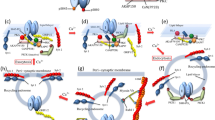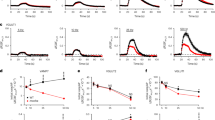Abstract
Although muscarinic acetylcholine receptors (mAChRs) and NMDA receptors (NMDARs) are important for synaptic plasticity, learning and memory, the manner in which they interact is poorly understood. We found that stimulation of muscarinic receptors, either by an agonist or by the synaptic release of acetylcholine, led to long-term depression (LTD) of NMDAR-mediated synaptic transmission. This form of LTD involved the release of Ca2+ from IP3-sensitive intracellular stores and was expressed via the internalization of NMDARs. Our results suggest that the molecular mechanism involves a dynamic interaction between the neuronal calcium sensor protein hippocalcin, the clathrin adaptor molecule AP2, the postsynaptic density enriched protein PSD-95 and NMDARs. We propose that hippocalcin binds to the SH3 region of PSD-95 under basal conditions, but it translocates to the plasma membrane on sensing Ca2+; in doing so, it causes PSD-95 to dissociate from NMDARs, permitting AP2 to bind and initiate their dynamin-dependent endocytosis.
This is a preview of subscription content, access via your institution
Access options
Subscribe to this journal
Receive 12 print issues and online access
$209.00 per year
only $17.42 per issue
Buy this article
- Purchase on Springer Link
- Instant access to full article PDF
Prices may be subject to local taxes which are calculated during checkout








Similar content being viewed by others
References
Collingridge, G.L., Kehi, S.J. & McLennan, H. Excitatory amino acids in synaptic transmission in the Schaffer collateral–commissural pathway of the rat hippocampus. J. Physiol. (Lond.) 334, 33–46 (1983).
Morris, R.G., Anderson, E., Lynch, G.S. & Baudry, M. Selective impairment of learning and blockade of long-term potentiation by an N-methyl-D-aspartate receptor antagonist, AP5. Nature 319, 774–776 (1986).
Bliss, T.V. & Collingridge, G.L. A synaptic model of memory: long-term potentiation in the hippocampus. Nature 361, 31–39 (1993).
Fujii, S., Saito, K., Miyakawa, H., Ito, K. & Kato, H. Reversal of long-term potentiation (depotentiation) induced by tetanus stimulation of the input to CA1 neurons of guinea pig hippocampal slices. Brain Res. 555, 112–122 (1991).
Dudek, S.M. & Bear, M.F. Homosynaptic long-term depression in area CA1 of hippocampus and effects of N-methyl-D-aspartate receptor blockade. Proc. Natl. Acad. Sci. USA 89, 4363–4367 (1992).
Mulkey, R.M. & Malenka, R.C. Mechanisms underlying induction of homosynaptic long-term depression in area CA1 of the hippocampus. Neuron 9, 967–975 (1992).
Collingridge, G.L., Peineau, S., Howland, J.G. & Wang, Y.T. Long-term depression in the CNS. Nat. Rev. Neurosci. 11, 459–473 (2010).
Bashir, Z.I., Alford, S., Davies, S.N., Randall, A.D. & Collingridge, G.L. Long-term potentiation of NMDA receptor–mediated synaptic transmission in the hippocampus. Nature 349, 156–158 (1991).
Abraham, W.C. & Bear, M.F. Metaplasticity: the plasticity of synaptic plasticity. Trends Neurosci. 19, 126–130 (1996).
Collingridge, G.L., Isaac, J.T. & Wang, Y.T. Receptor trafficking and synaptic plasticity. Nat. Rev. Neurosci. 5, 952–962 (2004).
Mulkey, R.M., Herron, C.E. & Malenka, R.C. An essential role for protein phosphatases in hippocampal long-term depression. Science 261, 1051–1055 (1993).
Mulkey, R.M., Endo, S., Shenolikar, S. & Malenka, R.C. Involvement of a calcineurin/inhibitor-1 phosphatase cascade in hippocampal long-term depression. Nature 369, 486–488 (1994).
Peineau, S. et al. LTP inhibits LTD in the hippocampus via regulation of GSK3beta. Neuron 53, 703–717 (2007).
Peineau, S. et al. A systematic investigation of the protein kinases involved in NMDA receptor–dependent LTD: evidence for a role of GSK-3, but not other serine/threonine kinases. Mol. Brain 2, 22 (2009).
Palmer, C.L. et al. Hippocalcin functions as a calcium sensor in hippocampal LTD. Neuron 47, 487–494 (2005).
Kim, M.J. et al. Synaptic accumulation of PSD-95 and synaptic function regulated by phosphorylation of serine-295 of PSD-95. Neuron 56, 488–502 (2007).
Xu, W. et al. Molecular dissociation of the role of PSD-95 in regulating synaptic strength and LTD. Neuron 57, 248–262 (2008).
Harvey, J., Balasubramaniam, R. & Collingridge, G.L. Carbachol can potentiate N-methyl-D-aspartate responses in the rat hippocampus by a staurosporine and thapsigargin-insensitive mechanism. Neurosci. Lett. 162, 165–168 (1993).
Markram, H. & Segal, M. Acetylcholine potentiates responses to N-methyl-D-aspartate in the rat hippocampus. Neurosci. Lett. 113, 62–65 (1990).
Shinoe, T., Matsui, M., Taketo, M.M. & Manabe, T. Modulation of synaptic plasticity by physiological activation of M1 muscarinic acetylcholine receptors in the mouse hippocampus. J. Neurosci. 25, 11194–11200 (2005).
Kirkwood, A., Rozas, C., Kirkwood, J., Perez, F. & Bear, M.F. Modulation of long-term synaptic depression in visual cortex by acetylcholine and norepinephrine. J. Neurosci. 19, 1599–1609 (1999).
Dickinson, B.A. et al. A novel mechanism of hippocampal LTD involving muscarinic receptor-triggered interactions between AMPARs, GRIP and liprin-α. Mol. Brain 2, 18 (2009).
Jo, J. et al. Experience-dependent modification of mechanisms of long-term depression. Nat. Neurosci. 9, 170–172 (2006).
Aramakis, V.B., Bandrowski, A.E. & Ashe, J.H. Role of muscarinic receptors, G proteins and intracellular messengers in muscarinic modulation of NMDA receptor–mediated synaptic transmission. Synapse 32, 262–275 (1999).
Jo, J. et al. Metabotropic glutamate receptor-mediated LTD involves two interacting Ca2+ sensors, NCS-1 and PICK1. Neuron 60, 1095–1111 (2008).
Volk, L.J., Pfeiffer, B.E., Gibson, J.R. & Huber, K.M. Multiple Gq-coupled receptors converge on a common protein synthesis–dependent long-term depression that is affected in fragile X syndrome mental retardation. J. Neurosci. 27, 11624–11634 (2007).
Harney, S.C., Rowan, M. & Anwyl, R. Long-term depression of NMDA receptor–mediated synaptic transmission is dependent on activation of metabotropic glutamate receptors and is altered to long-term potentiation by low intracellular calcium buffering. J. Neurosci. 26, 1128–1132 (2006).
Ireland, D.R. & Abraham, W.C. Mechanisms of group I mGluR–dependent long-term depression of NMDA receptor-mediated transmission at Schaffer collateral–CA1 synapses. J. Neurophysiol. 101, 1375–1385 (2009).
Burgoyne, R.D. Neuronal calcium sensor proteins: generating diversity in neuronal Ca2+ signaling. Nat. Rev. Neurosci. 8, 182–193 (2007).
Roche, K.W. et al. Molecular determinants of NMDA receptor internalization. Nat. Neurosci. 4, 794–802 (2001).
Hümmer, A. et al. Competitive and synergistic interactions of G protein β2 and Ca2+ channel β1b subunits with Cav2.1 channels, revealed by mammalian two-hybrid and fluorescence resonance energy transfer measurements. J. Biol. Chem. 278, 49386–49400 (2003).
Nakagawa, T. et al. Quaternary structure, protein dynamics and synaptic function of SAP97 controlled by L27 domain interactions. Neuron 44, 453–467 (2004).
Lin, Y., Skeberdis, V.A., Francesconi, A., Bennett, M.V. & Zukin, R.S. Postsynaptic density protein-95 regulates NMDA channel gating and surface expression. J. Neurosci. 24, 10138–10148 (2004).
Futai, K. et al. Retrograde modulation of presynaptic release probability through signaling mediated by PSD-95–neuroligin. Nat. Neurosci. 10, 186–195 (2007).
Lau, C.G. & Zukin, R.S. NMDA receptor trafficking in synaptic plasticity and neuropsychiatric disorders. Nat. Rev. Neurosci. 8, 413–426 (2007).
Tzingounis, A.V., Kobayashi, M., Takamatsu, K. & Nicoll, R.A. Hippocalcin gates the calcium activation of the slow afterhyperpolarization in hippocampal pyramidal cells. Neuron 53, 487–493 (2007).
Holbro, N., Grunditz, A. & Oertner, T.G. Differential distribution of endoplasmic reticulum controls metabotropic signaling and plasticity at hippocampal synapses. Proc. Natl. Acad. Sci. USA 106, 15055–15060 (2009).
Carroll, R.C. et al. Dynamin-dependent endocytosis of ionotropic glutamate receptors. Proc. Natl. Acad. Sci. USA 96, 14112–14117 (1999).
Migaud, M. et al. Enhanced long-term potentiation and impaired learning in mice with mutant postsynaptic density–95 protein. Nature 396, 433–439 (1998).
Bhattacharyya, S., Biou, V., Xu, W., Schlüter, O. & Malenka, R.C. A critical role for PSD-95/AKAP interactions in endocytosis of synaptic AMPA receptors. Nat. Neurosci. 12, 172–181 (2009).
Ehrlich, I., Klein, M., Rumpel, S. & Malinow, R. PSD-95 is required for activity-driven synapse stabilization. Proc. Natl. Acad. Sci. USA 104, 4176–4181 (2007).
Elias, G.M., Elias, L.A., Apostolides, P.F., Kriegstein, A.R. & Nicoll, R.A. Differential trafficking of AMPA and NMDA receptors by SAP102 and PSD-95 underlies synapse development. Proc. Natl. Acad. Sci. USA 105, 20953–20958 (2008).
Anderson, W.W. & Collingridge, G.L. The LTP program: a data acquisition program for on-line analysis of long-term potentiation and other synaptic events. J. Neurosci. Methods 108, 71–83 (2001).
Brummelkamp, T.R., Bernards, R. & Agami, R. A system for stable expression of short interfering RNAs in mammalian cells. Science 296, 550–553 (2002).
Acknowledgements
This work was funded by the Biotechnology and Biological Sciences Research Council (K.C.), the Medical Research Council (G.L.C.), UK Alzheimer's Research Trust (K.C. and D.W.), The Royal Society (J.J.) and Brain Research Centre of the 21st Century Frontier Research Programme, funded by the Korean Ministry of Education and Science and Technology (K.C. and G.L.C.).
Author information
Authors and Affiliations
Contributions
The study was conceived by K.C., and the experiments were designed by K.C., M.S. and G.L.C. The experiments were carried out by J.J., G.H.S., B.L.W., M.J.K., D.J.W., B.A.D., Y.-B.L., K.F. and M.A., and the manuscript was written by G.L.C., M.S. and K.C.
Corresponding author
Ethics declarations
Competing interests
The authors declare no competing financial interests.
Supplementary information
Supplementary Text and Figures
Supplementary Figure 1 (PDF 42 kb)
Rights and permissions
About this article
Cite this article
Jo, J., Son, G., Winters, B. et al. Muscarinic receptors induce LTD of NMDAR EPSCs via a mechanism involving hippocalcin, AP2 and PSD-95. Nat Neurosci 13, 1216–1224 (2010). https://doi.org/10.1038/nn.2636
Received:
Accepted:
Published:
Issue Date:
DOI: https://doi.org/10.1038/nn.2636
This article is cited by
-
PIP3-Phldb2 is crucial for LTP regulating synaptic NMDA and AMPA receptor density and PSD95 turnover
Scientific Reports (2019)
-
Long term potentiation, but not depression, in interlamellar hippocampus CA1
Scientific Reports (2018)
-
Acetylcholine-modulated plasticity in reward-driven navigation: a computational study
Scientific Reports (2018)
-
Phospholipase D1 Signaling: Essential Roles in Neural Stem Cell Differentiation
Journal of Molecular Neuroscience (2018)
-
STEP activation by Gαq coupled GPCRs opposes Src regulation of NMDA receptors containing the GluN2A subunit
Scientific Reports (2016)



